Quick Links
Advertisements
No ends building toy
Great geeky toys
Categories
Archives
XML/RSS Feed
Statistics
Total entries in this blog:
Total entries in this category:
Published On: Nov 13, 2009 08:19 AM
Total entries in this category:
Published On: Nov 13, 2009 08:19 AM
Related websites
Geometric Toy
Supermagnetic Polyhedra
Architectural Toys
Zomeworld (list)
Polytopia (list)
Math Toys Community at Orkut (requires invitation to join orkut - e-mail me to request one)
Supermagnetic Polyhedra
Architectural Toys
Zomeworld (list)
Polytopia (list)
Math Toys Community at Orkut (requires invitation to join orkut - e-mail me to request one)
Geofix (Geoshapes)
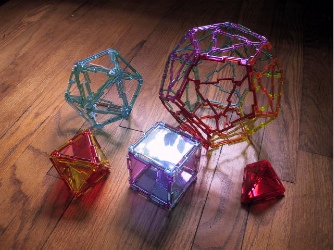
Here
are the five platonic solids: tetrahedron, cube, octahedron, dodecahedron, and
icosahedron. I've inserted the optional flat transparent windowpanes into faces
of the three smallest figures.
Geofix is the American name for what is called Geoshapes in Australia, where it's made. (Geoshapes in the US refers to a children's educational board game.) I bought mine from The Construction SIte, a toy store. Didax sells a miniature Geofix set as well as some different Geofix kits than The Construction Site, but at considerably higher prices.
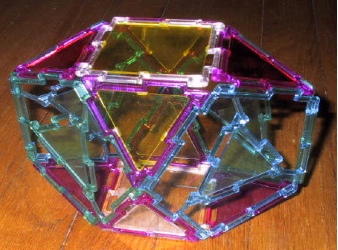
Above is a bilunabirotunda (one of the Johnson solids), made with four pentagons, two squares, and eight triangles.
More complex shapes can be constructed as flat "nets" of polygons and then assembled into the three-dimensional shape, such as the Great Rhombicosi dodecahedron in the two pictures below, which looks rather like a huge colorful soap bubble (note cat behind the assembled shape, for scale):

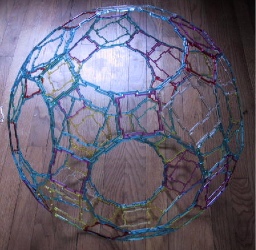
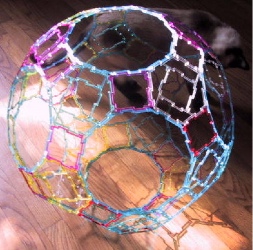
It's almost two feet in diameter, and is composed of twelve decagons, twenty hexagons, and thirty squares.
Geofix is much more fun, for those who care about geometry, if you also download the program Poly to show you how to make (and name!) the more complex geometric solids. It includes the ability to generate Geofix-style nets for the Platonic solids, the Archimedean soilids, prism and anti-prisms, and Johnson solids.
Three-quarters of a stellated icosahedron (missing five points on the base):

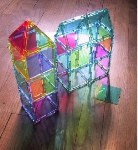
Of course, you can also make castles and rocket ships from a set of Geofix. (Note that the window inserts are too difficult for most children to use, unlike the polygons themselves, which can be used happily by a dexterous five-year-old.)
There are two other toys, though I haven't yet played with them, that allow the construction of polyhedra by assembling polygons edge-to-edge. Neither is nearly as pretty as the translucent, jewel-tone Geofix, but they have their advantages, as well. Polymorf has a web site with lots of great information about polyhedra; it has hinges which allow the construction of pistons, and it looks as though it may be sturdier; Polydron includes wheels, axles, and swivel joints, and thus may be more interesting for those children who happen to care less about geometry. Polymorf appears to be less expensive, per piece, than either Geofix or Polydron.
Geofix is the American name for what is called Geoshapes in Australia, where it's made. (Geoshapes in the US refers to a children's educational board game.) I bought mine from The Construction SIte, a toy store. Didax sells a miniature Geofix set as well as some different Geofix kits than The Construction Site, but at considerably higher prices.

Above is a bilunabirotunda (one of the Johnson solids), made with four pentagons, two squares, and eight triangles.
More complex shapes can be constructed as flat "nets" of polygons and then assembled into the three-dimensional shape, such as the Great Rhombicosi dodecahedron in the two pictures below, which looks rather like a huge colorful soap bubble (note cat behind the assembled shape, for scale):



It's almost two feet in diameter, and is composed of twelve decagons, twenty hexagons, and thirty squares.
Geofix is much more fun, for those who care about geometry, if you also download the program Poly to show you how to make (and name!) the more complex geometric solids. It includes the ability to generate Geofix-style nets for the Platonic solids, the Archimedean soilids, prism and anti-prisms, and Johnson solids.
Three-quarters of a stellated icosahedron (missing five points on the base):


Of course, you can also make castles and rocket ships from a set of Geofix. (Note that the window inserts are too difficult for most children to use, unlike the polygons themselves, which can be used happily by a dexterous five-year-old.)
There are two other toys, though I haven't yet played with them, that allow the construction of polyhedra by assembling polygons edge-to-edge. Neither is nearly as pretty as the translucent, jewel-tone Geofix, but they have their advantages, as well. Polymorf has a web site with lots of great information about polyhedra; it has hinges which allow the construction of pistons, and it looks as though it may be sturdier; Polydron includes wheels, axles, and swivel joints, and thus may be more interesting for those children who happen to care less about geometry. Polymorf appears to be less expensive, per piece, than either Geofix or Polydron.
Posted: Sun - May 30, 2004 at 01:26 PM